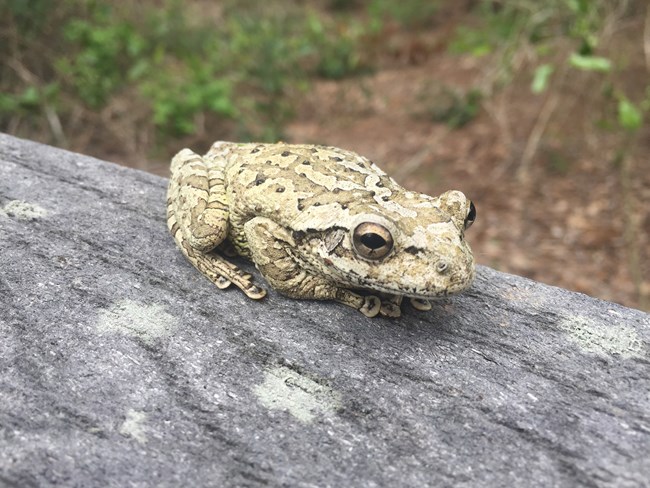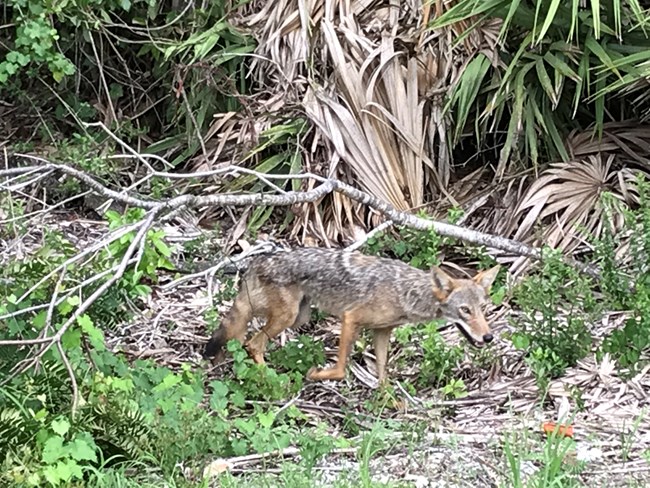
Cuban Tree FrogsCuban treefrogs are an introduced species to Florida that are native to Cuba and other Caribbean islands. It is likely that these frogs were accidentally brought to Florida on cargo ships during the 1920s. Cuban treefrogs are considered an invasive species to Florida, causing harm to the ecosystem and eating native species of frogs. After a rainstorm, these are some of the most common frogs heard throughout the park.Cuban treefrogs are also considered a nuisance to humans. They like moist areas like bird baths and ponds, and they have been found inside toilets and sink drains. Cuban treefrogs grow very large and can even cause power outages due to short-circuiting. These frogs are covered in a slime that can be irritating to humans if their mucus gets into your eyes or mouth. Cuban treefrogs have toepads that expand at the tips to help them climb trees and are much larger than native treefrogs. They can exceed 6 inches in length, have large eyes, and have warty skin with wavy or blotchy patterns on their back. Their colors can range from green to brown to yellow. It may be difficult to differentiate Cuban treefrogs from their native counterparts, but their size will be the biggest difference to help you identify this species. Native species of treefrog only grow to about 1.5 – 2.5 inches. Floridians are encouraged to help native wildlife by humanely euthanizing Cuban treefrogs that are found at their house by applying 20% benzocaine (first aid or burn spray) to the back and belly of the frog, sealing the frog in a plastic bag, and placing it in the freezer overnight prior to disposing of the frog. 
CoyotesCoyotes are native to relatively open country in the western United States, Mexico, and southern parts of Canada, but they have made swift population expansions throughout most of North America in the past century. Coyotes can now be found in every county in Florida with the first coyotes spotted around the 1960s. The expansion of coyotes has been linked directly to the removal of wolves and mountain lions from the east coast. This allowed coyotes to expand into territory that was previously occupied by these top apex predators. As well, coyotes expanded east from the plains once forests were cleared by logging for agriculture and development.These opportunistic predators have adapted to human-dominated environments like cities and neighborhoods. They scavenge for their food and will consume a variety of animals from reptiles to deer (including mice and bird chicks), eggs, grasses, and fruit. While attacks on humans are very rare, they have been known to attack pets and livestock. As mentioned earlier, coyotes are very good at adapting to new environments! Some locals may mention that the coyotes they have seen in Florida are bigger than those seen out west. This is due to crossbreeding with wolves and domestic dogs. You can read more about the differences between western and eastern coyotes here: NETN Species Spotlight Coyotes have become established throughout Florida, which can have negative impacts on native wildlife species. Coyotes have been documented eating shorebird and sea turtle eggs. With a nesting colony of vulnerable least terns and nesting sea turtles throughout the summer months, these predators can have detrimental impacts on our populations of native species. If you see a coyote near your house, there are a few methods to deter coyotes: · Startle the coyote with loud noises and by waving your arms · Teach children about the dangers of coyotes and how to react if one is spotted · Keep your pets on a leash and supervise them · Install motion sprinklers or lights · Secure your garbage cans 
Saint Johns County Cactus MothCactus Moths, Cactoblastis cactorum, are native to South America, and they were introduced to different parts of the world to control the spread of prickly pear and related cacti. The introduction of the Cactus Moth to the United States is likely due to surrounding areas utilizing it as a pest control for cacti. Now, they are posing a great threat to prickly pear cacti at Fort Matanzas National Monument. They begin as egg sticks, deposited by the mother on a prickly pear cactus host plant. These egg sticks can contain about 70 eggs! The egg sticks resemble the normal cactus spines found on the plant, but there are ways to distinguish them. Instead of being straight and rigid like a normal spine, they are slightly curved and easy to remove. Once the eggs hatch, the larvae crawl up towards the cactus pad and burrow inside it. These ferocious consumers will eat the cactus from the inside out. When they are ready, they will create a cocoon within the leaf litter of the remaining cactus. Finally, the moth will emerge, and the cycle will repeat again. Cactus Moths are detrimental to prickly pears within the dune ecosystem. Prickly pears are a commodity for gopher tortoises looking for a snack. Pollinators utilize the nectar of the flowering plant. Overall, cactus moths can decimate the prickly pears present in our unique ecosystem. Current invasive species management efforts are underway, including monitoring and removal. Ambrosia BeetleAmbrosia Beetles, Xyleborus glabratus, are native to southeast Asia, including countries such as Japan, India, and Taiwan. They have spread to the United States through untreated wood packaging material coming from other countries. Ambrosia Beetles are particularly damaging to redbay trees, Persea borbonia, found at Fort Matanzas National Monument. Ambrosia Beetles are wood-boring insects that carry a symbiotic fungus, Raffaelea lauricola. When the beetle attacks a tree, its mandibles inject the lethal spores of the fungi that will terminate the water and food conducting systems of the plant. This causes the tree to die within a few weeks or months. During this time, the adult and larval beetles living in the tree will consume the fungus. After the tree has outlived its usefulness, the cycle will repeat again with a different redbay tree. Ambrosia Beetles are detrimental to redbay trees within our coastal ecosystems. Redbay trees are important for various organisms including insects and birds who consume different parts of the tree. The annihilation of redbay trees could pose negative consequences for those organisms and the overall biodiversity of coastal ecosystems in Florida. |
Last updated: August 16, 2024
